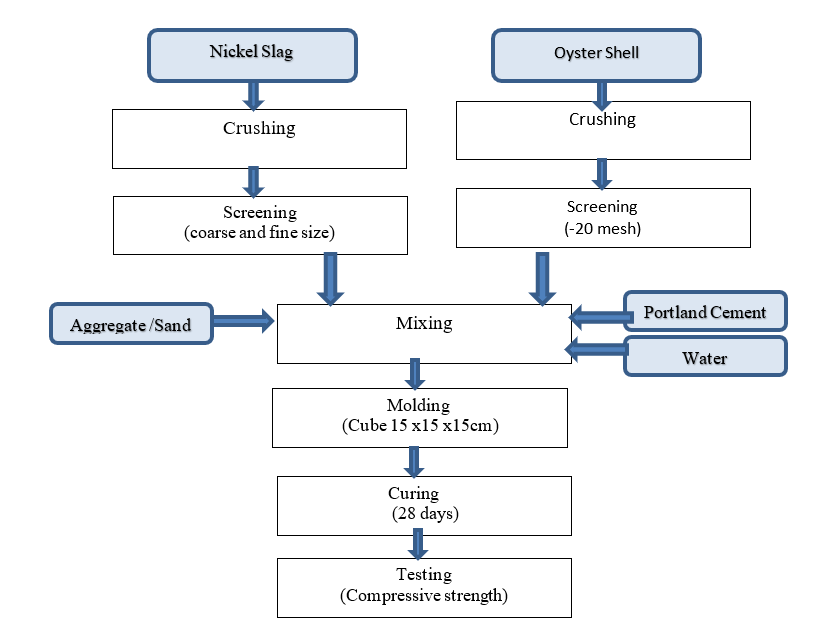The Utilization of Nickel Slag and Oyster Shell to Improve the Concrete Strength
DOI:
https://doi.org/10.26555/ijce.v2i2.1021Keywords:
Concrete, Compressive Strength, Nickel , Slag, Oyster shellAbstract
The increasing mining industry activity will produce increasing industrial waste. Nickel slag is one of the wastes produced from the nickel refining process by-products that have not been optimally utilized. The chemical composition of nickel slag is mostly silica with a percentage of 47.93%. Silica can be used as a material for making concrete, where a high percentage of silica is expected to strengthen the concrete structure. This study was conducted to determine the effect of nickel slag on the compressive strength of concrete and the right composition in the concrete mixture. The research method used an experimental method with different nickel slag compositions (0%, 5%, 10%, 15%, and 20%) with concrete compressive strength testing at the age of 28 days. The results of the concrete compressive strength test were that the higher the nickel slag content, the higher the compressive strength and flexural strength of the concrete. The addition of shells with different variations (0%, 5%, 10%, 15%, and 20%) showed that the best results were with the addition of 10% shells with a compressive strength of 28.1 MPa. Meanwhile, the water absorption capacity with the lowest absorption power was obtained by adding 20% nickel slag, which was 8.95 %.
References
[1] Mustika, W., A. Kadir, E. Ngii And M. Nurdin. 2021. Properties Of Concrete Paving Blocks Made With Nickel Slags. Iop Conference Series. Eart And Environmental Science 622 (1):012033. Https://Doi.Org/10.1088/1755-1315/622/1/012033
[2] Manggolo, Muhammad Arfan, Mohammad Salman Said, Arif Nurwaskito, Firman Nullah Yusuf And Alfian Nawir. 2021. Analisis Pencemaran Limbah Slag Ferronikel Terhadap Lingkungan Air Dan Tanah Di Kecamatan Pomalaa. Jurnal Geosapta 7(1):21.
[3] Puspitasari Dan Mirana. 2010. Rekayasa Penulangan Geser Balok Beton Bertulang Dengan Menggunakan Sengkang Vertikal Model “U”.
[4] Sni 1974-2011. Cara Uji Kuat Tekan Beton Dengan Benda Uji Silinder, Standar Nasional Indonesia
[5] Ahmad, Irma Aswani, Nur Anny Suryaningsih Taufieq And Abdul Hamid Aras. 2009. Analisis Pengaruh Temperatur Terhadap Kuat Tekan Beton. Jurnal Teknik Sipil 16(2):63. Https://Doi.Org/10.5614/Jts.2009.16.2.2
[6] B. A. Tayeh, M. W. Hasaniyah, A. M. Zeyad, And M. O. Yusuf, “Properties Of Concrete Containing Recycled Seashells As Cement Partial Replacement : A Review,” J. Clean. Prod., 2019, Doi: 10.1016/J.Jclepro.2019.117723.
[7] S. U. D. Muhammad Taufik Kurniawan, Agus Surandono, “Material Tambahan Pada Campuran Beton Terhadap Kuat Tekan Beton,” Vol. 2, No. 1, 2021.
[8] R. Sriyani, E. Ngii, A. Kadir, M. Hasbi, And U. Mangidi, “The Effect Of Nickel Slag Concentrationas Coarse Aggregates On The Compressive Strength Of Concrete,” Pp. 3–7, 2019, Doi: 10.4108/Eai.1-4-2019.2287229.
[9] S. A. E. V. Eristra Ernawan, Jessica Sjah, Nuraziz Handika, “Mechanical Properties Of Concrete Containing Ferronickel Slag As Fine Aggregate Substitute Using Digital Image Correlation Analysis,” 2023.
[10] M. Olivia, A. Arifandita, And L. Darmayanti, “Mechanical Properties Of Seashell Concrete,” Procedia Eng., Vol. 125, Pp. 760–764, 2015, Doi: 10.1016/J.Proeng.2015.11.127.
[11] G. Sai, Y. Shen, J. Chong, And H. Yang, “Deformation Pattern Of Nickel Slag Bonding On The Development Of Concrete Construction Deformation Pattern Of Nickel Slag Bonding On The Development Of Concrete Construction,” 2017.
[12] Y. Zhu, D. Chen, X. Yu, R. Liu, And Y. Liao, “Properties Of Cementitious Materials Utilizing Seashells As Aggregate Or Cement : Prospects And Challenges,” 2024.
[13] E. Yanuarini Et Al., “Pengaruh Subtitusi Slag Nikel Dan Fly Ash Terhadap Kuat Tekan Beton Sebagai Pemecah Gelombang,” Vol. 9, No. 1, Pp. 1–8, 2022.
[14] B. B. Materials, B. Gonzalez, And D. Carro, “Effects Of Seashell Aggregates In Concrete Properties,” Vol. 33, No. 2, Pp. 376–382, 2015.
[15] K. K. Poloju, V. Anil, S. Hamed, N. Ali, R. Malik, And N. Al, “Investigating Possibilities For Using Sea Shell On Compressive Strength Properties Of Concrete,” No. January, 2020, Doi: 10.14419/Ijet.V7i1.9399.
[16] W. M. Et Al, “Properties Of Concrete Paving Blocks Made With Nickel Slags,” 2021, Doi: 10.1088/1755-1315/622/1/012033.
[17] Q. Wu, Y. Wu, W. Tong, And H. Ma, “Utilization Of Nickel Slag As Raw Material In The Production Of Portland Cement For Road Construction,” Constr. Build. Mater., Vol. 193, Pp. 426–434, 2018, Doi: 10.1016/J.Conbuildmat.2018.10.109.
[18] K. P. Ramaswamy, “A Review On Seashells Ash As Partial Cement Replacement A Review On Seashells Ash As Partial Cement Replacement,” Pp. 0–7, Doi: 10.1088/1757-899x/271/1/012059.
[19] Z. Chen And S. Li, “Effect Of Nickel Slag As A Sand Replacement In Strength And Workability Of Concrete Effect Of Nickel Slag As A Sand Replacement In Strength And Workability Of Concrete,” 2019, Doi: 10.1088/1757-899x/615/1/012014.
[20] D. Yang, H. Li, H. Yue, L. Ge, And W. Wang, “Research On Nickel Slag Powder As Concrete Mineral Admixture,” Vol. 1069, Pp. 1825–1832, 2015, Doi: 10.4028/Www.Scientific.Net/Amr.1065-1069.1825.

Downloads
Published
Issue
Section
License
Copyright (c) 2024 Maryudi Maryudi, Sartika S. Selang, Zahrul Mufrodi, Sri Rahayu Widyaningrum

This work is licensed under a Creative Commons Attribution-ShareAlike 4.0 International License.



